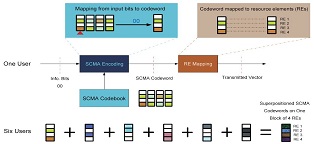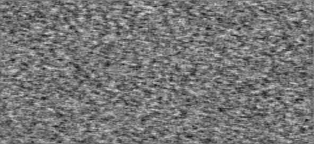My recent research interests include Noncoherent communication, Channel-coded Communication Systems, Cooperative Communication, Large-scale MIMO System, Non-orthogonal Multiple Access, and Biometrics.
The detailed publication list can be found in the following page : http://mx.nthu.edu.tw/~ymchen/publications.htm
The main contributions in some of the topics are described in the following.
1. Noncoherent communication:
In wireless links, the variation of channel environments can be explicitly modeled by time-varying amplitudes and carrier phase rotations of channel coefficients. For systems with unknown channel coefficients to both the transmitter and the receiver, non-coherent detection is an attractive technique, since it does not require the channel estimation procedures. However, the noncoherent detection methods provided in literature usually suffer from high computational complexities, most of which are exponentially proportional to the number of conveyed information bits. To overcome this major drawback of noncoherent detection, we firstly focused on the design of low-complexity noncoherent detectors. Noncoherent detectors with very low detection complexities were proposed respectively for both the single-input single-output (SISO) and the multiple-input multiple-output (MIMO) noncoherent communication schemes, with only limited losses in bit-error-rate performances.
Secondly, coded centralized/distributed MIMO schemes for non-coherent fast fading channels, where neither the transmitter nor the receiver knows the channel state information, were proposed. The coded bits are transmitted through either unitary space-time modulation (USTM) or spatial multiplexing (SM). Since this approach effectively increases the cardinality of the set of possible transmit (space-time) signal matrices, a large rate gain can be obtained without increasing the modulation order, as shown through achievable-rate analysis. At the receiver, an iterative detection-decoding algorithm is executed cooperatively among the decoder, the coherent detector used for SM, and the non-coherent detector used for USTM. Compared to the scheme described in the literature, the proposed scheme, in some cases, can provide better error performance with lower complexity.
Lastly, in the recently published research results, we used high-order modulation signals to construct coded non-coherent transmission schemes. Considering amplitude/phase modulated signals, the theoretical analyses of bit error rates were investigated, and the design criteria for the noncoherent signal constellations as well as the bit labeling rules were derived for both the Rayleigh block fading channels and the correlated Rayleigh fading channels, respectively. We also optimized the system parameters such that near-capacity performances can be achieved for both channels.
2. Channel-coded communication systems:
In the research field of channel-coded communication systems, we firstly proposed a method that can be used to approach the capacity limit for channels with fast phase variation by using a serial concatenation scheme with an outer channel encoder and an inner block modulator. A distinct feature of the proposed transmission scheme is that coded symbols from adjacent codewords are interleaved into the same input vectors of the block modulator. It was shown that near-capacity performances can be achieved using the proposed concatenated schemes. On the other hand, when considering convolutional codes as the outer channel codes, design criteria for the generator polynomials of the convolutional codes were also derived through the bit-error-rate analysis of the entire coded system.
Secondly, it is known that low-density parity-check (LDPC) codes are widely used to provide capacity-approaching performances in various transmission systems. For the design of LDPC-coded transmission schemes, the extrinsic information transfer (EXIT) chart is a commonly used tool for the performance optimization. However, the Gaussian assumption for soft messages in conventional EXIT-chart-based optimization algorithms result in prediction gaps in the decoding threshold for certain transmission systems. Consequently, we propose an EXIT-chart-based optimization method, in which all the Gaussian assumptions for soft messages can be avoided. Compared to the conventional design methods, the proposed method provides a more accurate threshold prediction and can be used to designed LDPC-coded schemes with better error performances.
Lastly, efficient scheduling methods for the decoding algorithm of LDPC-like channel codes were also proposed to improve the converged decoding threshold and enhance the throughput performance of the coded schemes. Moreover, considering noncoherent distributed space-time modulations, code design algorithms for the outer Raptor codes were investigated in the recent research results.
3. Cooperative communication and large-scale MIMO system:
Firstly, several full-duplex cooperative coherent communication systems for Rayleigh fading channels using rateless codes were investigated based on the decode-and-forward (DF), the compress-and-forward (CF), and the adaptive CF/DF (ACDF) relaying protocols. Secondly, we also proposed two Raptor-coded noncoherent cooperative schemes based on distributed unitary space-time modulation schemes. Considering a wireless relay network with one source node, one destination node, and multiple relay nodes, not only the noncoherent distributed space-time signal sets were designed, but also the relaying protocols were investigated. In addition, aiming at enhancing the convergence speed and the data throughput, a joint code search and signal design algorithm is investigated for the proposed noncoherent cooperative schemes. The related research works are supported by the Ministry of Science and Technology of Taiwan under Grants MOST 104-2218-E-110-012-MY2
Secondly, we have proposed a coded low-complexity massive MIMO scheme considering the generalized spatial modulation in large-scale MIMO systems. Reductions in detection complexity of 99.46% can be achieved when compared to the scheme which uses the ML detector, when considering the 16QAM signal. Moreover, an LDPC-coded GSM scheme that uses the designed CASD detector has been constructed. The variable-node degree distributions of suitable LDPC codes have been designed in order to achieve an error performance which is very close to that of the scheme using the conventional MAP detector, but with a much lower complexity level.
Lastly, a cooperative single-carrier transmission scheme, which considers a distributed quasi-orthogonal space-frequency block code (QOSFBC) that provides improved peak-to-average power ratio (PAPR) values, is constructed for uplink communications. Aiming at reducing the size and computational complexity, the source node is equipped with two transmit antennas, while only one antenna is equipped at the relay node to collaboratively generate a distributed QOSFBC signal with four transmit antennas. To achieve full diversity, a phase rotation strategy is adopted at the relay node. In addition, since single-carrier schemes which consider SFBCs re-permute the spectral elements of the transmitted signals and induce high PAPR values, a modified SFBC coding strategy is proposed to mitigate the high-PAPR problem. Consequently, the constructed distributed single-carrier frequency-division multiple access (SC-FDMA) QOSFBC scheme is capable of providing full transmit diversity over frequency-selective fading channels, with a much lower PAPR value on mobile devices when compared to a conventional SC-FDMA QOSFBC scheme.
NON-ORTHOGONAL MULTI-ACCESS

在4G時代,通訊系統多數採用正交系列的技術應用,如: 分碼多重接取(Code Division Multiple Access,CDMA),正交頻多重接取(Orthogonal Frequency Division Multiple Access,OFDMA)...
NON-ORTHOGONAL MULTI-ACCESS
NOMA被認為是5G和Beyond 5G有力的候選方案,而與傳統的OMA方案相反,NOMA的主要區別特徵是在非正交(Non-Orthogonal)資源分配的輔助下,與正交(Orthogonal)資源相比,它支援的用戶數更多,而此技術會通過消除用戶間複雜的干擾來實現支援更多的用戶數,但也因此增加接收機的複雜度為代價。
而在傳統的4G網絡中,正交頻分多址(OFDMA)作為OFDM自然延伸的技術,其中將每個用戶的信息分配給子載波的子集。另外在NOMA中,每個用戶都可以使用所有子載波。現今因為進階多媒體應用(例如,超高清視頻,虛擬實境(VR)等)所需的無線網路速度迅速提升,以及物聯網(IoT)所要求的用戶訪問需求急劇增長,第五代(5G)網絡在支持大規模數據流量方面面臨挑戰。而非正交多址(NOMA)是第三代合作夥伴計劃長期演進(3GPP-LTE-A)所提出的一種有發展性的技術。現有的NOMA依賴於 power-domain 或 code-domain 的復用(multiplexing),因此能夠借助非正交資源共享來提高頻譜效率。而且,NOMA這個技術能夠在等級不足(rank-deficient)的情況下運行,從而有助於支持大規模連接,所以NOMA被認為是一個非常有潛力的5G候選方案。
在code-domain上,NOMA的相關技術有低密度簽記(LDS)、疏碼多工存取(SCMA)、模式多重接取(PDMA),低密度簽記是一種低密度版本的CDMA。使得我們可以用可行複雜度的接收機來達到近似MAP的性能。而SCMA則是希望改善LDS的錯誤率性能,同時保留低密度的特性使得一樣能合理使用近似MAP性能的接收機。跟LDS步驟最大的不同在於位元轉換成星座符元的映射以及擴展成會合併在一起的SCMA碼本映射。所以位元會透過SCMA碼本轉換成多維度的碼字。每個用戶會有自己專門的碼本,所以SCMA可以想成是一個二進位維度變成多維的複數維度編碼流程。與CDMA相比,多維度碼字調變技術的星座成型增益(constellation shaping gain)是主要優勢所在。
而在power-domain上,NOMA的分集增益(diversity gain)主要源自於傳輸訊號在power-domain上的功率疊加,已經有許多研究結果(例如,outage probability、achievable capacity、weak users’ rate guarantees、 cell-edge user experiences)顯示有利於NOMA。
此外,在傳送端完美的SC、在接收端的零錯誤SIC、最佳化功率分配、面向QoS使用者保障、適當的用戶配對以及良好的鏈路適應性,皆可為NOMA提供最大的優勢。
本實驗室長期以來在頻譜利用效率的通訊研究上已有相當成果,目前的研究方向著重在疏碼多工存取(SCMA)的相關技術,透過AI來尋找更好的SCMA碼本來達成錯誤率下降。歡迎有興趣的新生加入本研究群的行列!
ERROR-CORRECTING CODE

在現今的社會中,通訊技術實現在人們的日常生活,大家都想正確的將訊息傳達給遠處的人。但是在現實中往往會因為自然環境產生的干擾或電子零件產生的雜訊,使得資料傳輸時產生失真,讓接收到的資料產生錯誤...
ERROR-CORRECTING CODE
在現今的社會中,通訊技術實現在人們的日常生活,大家都想正確的將訊息傳達給遠處的人。但是在現實中往往會因為自然環境產生的干擾或電子零件產生的雜訊,使得資料傳輸時產生失真,讓接收到的資料產生錯誤,這時候如果有方法可以將收到的錯誤資訊還原回正確的資料,就可以避免不可靠的通訊。
學者Claude Shannon在所建構的消息理論中昭示,只要符合通道的特定條件,就可能使得訊息傳輸發生錯誤的機率達到任意小,同時還告訴我們在特定的通道環境假設下,錯誤效能的極限在哪裡,從此之後,使得通訊系統的研究進入一個新的階段,有眾多科學家研究他的理論,並促使錯誤更正碼(Error Correcting Code)的研究領域蓬勃發展。
為了克服通道環境引起的傳輸錯誤而加諸於傳送訊息的編碼方法,是使用錯誤更正碼(Error Correcting Coding)在傳送訊息中加入冗餘(Redundancy)位元,讓接收端的解碼器能經由所設計的編碼架構去偵測並更正傳輸錯誤,因此在同一訊號雜訊比時,位元錯誤率會降低,但也會導致整體傳輸位元數增加,而使得傳輸速率降低,設計時須同時考慮這兩個因素。
本實驗室目前所專注之編碼研究為低密度奇偶檢查碼(Low density parity check code)和極化碼(Polar code) 在近年Polar Code 已被3GPP納入Control Channel的5G標準當中,Polar Code是本實驗室錯誤更正碼方向上所著重的研究題目之一。歡迎對5G前瞻行動通訊技術有興趣的新生加入我們的研究團隊!
CRYPTOSYSTEM ON BIOMETRIC

雖然以指紋、虹膜為代表的生物辨識系統,在辨識精確度和速度上已經可以滿足實用的要求,但是系統的安全性卻不一定能得到可靠的保證。以指紋為例,傳統的指紋辨識系統大多數採用細節點(minutiae)作為辨識的特徵...
Biometric
雖然以指紋、虹膜為代表的生物辨識系統,在辨識精確度和速度上已經可以滿足實用的要求,但是系統的安全性卻不一定能得到可靠的保證。以指紋為例,傳統的指紋辨識系統大多數採用細節點(minutiae)作為辨識的特徵,並且將細節點位置、方向等資訊以裸資料的形式儲存作為範本(Template)以便比對。通常人們認為,該儲存的範本內容是指紋細節點資訊,而不是原始的指紋影像,不會洩漏原始的指紋資訊。然而,已有研究成果表明,攻擊者能以成功率高於95%的機率,從指紋細節資料恢復出原始的指紋影像,進而用該影像攻擊原系統。另一方面,生物特徵的持久性和穩定性使得它能伴隨人的一生,然而一旦丟失,將導致永久性傷害,因為一但被成功攻擊,該生物特徵將永久不可用。人的生物特徵是有限的,不像密碼或者身分卡可以隨意撤銷更改。由此可見,在這樣的應用環境中,生物特徵的固有性反而成為了缺陷。
雖然以指紋、虹膜為代表的生物辨識系統,在辨識精確度和速度上已經可以滿足實用的要求,但是系統的安全性卻不一定能得到可靠的保證。以指紋為例,傳統的指紋辨識系統大多數採用細節點(minutiae)作為辨識的特徵,並且將細節點位置、方向等資訊以裸資料的形式儲存作為範本(Template)以便比對。通常人們認為,該儲存的範本內容是指紋細節點資訊,而不是原始的指紋影像,不會洩漏原始的指紋資訊。然而,已有研究成果表明,攻擊者能以成功率高於95%的機率,從指紋細節資料恢復出原始的指紋影像,進而用該影像攻擊原系統。另一方面,生物特徵的持久性和穩定性使得它能伴隨人的一生,然而一旦丟失,將導致永久性傷害,因為一但被成功攻擊,該生物特徵將永久不可用。人的生物特徵是有限的,不像密碼或者身分卡可以隨意撤銷更改。由此可見,在這樣的應用環境中,生物特徵的固有性反而成為了缺陷。
我們團隊以生物特徵加密系統為主要研究的目標,因為錯誤更正碼對於絕大多數的生物特徵加密系統都存在舉足輕重的價值,此一關鍵技術也是本團隊對此研究方向切入的優勢所在。生物特徵加密系統中存在兩個研究主流: (1)模糊承諾方案(Fuzzy Commitment Scheme): Juels 和Wattenberg於1999年提出了一種模糊承諾方案,他們將錯誤更正碼技術與生物特徵結合在一起形成一種典型的密鑰綁定方案。這個方案是由密碼學的比特承諾方案(bit commitment scheme)延伸而來,並藉用了其中的承諾、證據等概念,將其用於生物特徵這種本質上模糊(fuzzy)的資料中。(2)模糊保險箱方案(Fuzzy Vault Scheme): 模糊保險箱方案是指紋加密領域最為經典的實用化方案。該方案最初由Juels與Sudan二人於2002年在模糊承諾方案的基礎上提出。其演算法最大的特點,是添加以假亂真的雜湊點(Chaff points)的加密過程,並很好地把生物特徵的模糊性和密碼演算法的精確性相結合。歡迎有興趣的新生加入本研究群的行列!
Noncoherent Detection
_resized.jpg)
在一般的通訊系統的設計,常常基於通道資訊在接收端完美已知的假設之下進行討論,或假設通道估計可完美的進行。然而,在現實的無線通道環境中,傳送端與接收端的移動性(mobility)...
在一般的通訊系統的設計,常常基於通道資訊在接收端完美已知的假設之下進行討論,或假設通道估計可完美的進行。然而,在現實的無線通道環境中,傳送端與接收端的移動性(mobility),相位同步問題,以及其它可能的因素常會導致未知且時變的衰退通道。尤其在通道變化快速的形況下,接收端往往難以做到精確的通道估計。
通道估計問題在許多情況下將特別難以實現。例如在分散式多輸入多輸出系統中,為了形成一個虛擬天線陣列,我們必須將傳送資訊可靠的傳遞到每個中繼端點,這暗示了精確通道估計必須在每個中繼端點(虛擬傳送天線)上被實現。在快速衰退通道下,我們需要使用相當多的嚮導信號(pilot symbol)來達到精確通道估計的效果。如此一來將導致頻寬和傳送能量上的浪費,然而,這兩項卻恰恰是在行動裝置上十分珍貴的資源。另外,在現今5G的候選技術中,大規模多天線(Massive MIMO)系統是一個相當受矚目的技術,預計可顯著的提升系統吞吐量與傳輸可靠度。然而,在一個大規模多天線系統中,由於通道鏈結為數眾多,花費在通道估測上所需嚮導訊號將造成大量能量與頻寬上的浪費。因此,通道估測實行上的困難成為大規模多天線系統實現上所將面對的一個重要議題。
因此,為了解決複雜的通道估測問題,非同調(Noncoherent)通訊架構,即,在傳送端與接收端都不需要通道資訊的假設下的系統,是一個可能的解決方案。
透過非同調訊號與相對應接收機的設計,接收端不需進行通道估測,依然可以進行訊號解調。然而,在MIMO環境下,當傳送天線的數量增加,非同調架構的設計依然面臨兩個極具挑戰性的難題:第一個問題是在文獻中提到,在非同調區塊衰退通道下,為了達到全分集(full diversity),所設計的訊號矩陣時間長度須為傳送天線的兩倍。如此一來若考慮大規模的傳送天線數量,將與基於通道估測的系統相似,遭受較長的訊號延遲與頻寬效益上的浪費。另一個問題是,傳統非同調訊號的設計通常不具有良好的結構性,且使用最大相似性(maximum likelihood, ML)偵測器來進行訊號解調。在考慮較長的訊號矩陣時間長度且較高的調變率(modulation rate)的情形下,使用最大相似性偵測器將帶來極高的解調複雜度。因此,以上兩個議題將是非同調大規模多天線系統設計上極具挑戰性的難題。
本實驗室長期以來在非同調通訊的研究上已有相當成果,目前的研究方向著重在結合壓縮感知 (compressed sensing)的相關技術,進行低複雜度非同調大規模多天線編碼傳輸架構設計。歡迎有興趣的新生加入本研究群的行列!
Semantic JSCC

Shannon在消息理論中提出,訊息編碼與通道編碼可分開設計與實現而不會影響整體系統的最佳性。然而,此結論是漸進式的,而且是基於無限制的碼長與編碼延遲等假設。在許多貼近現實的環境...
Semantic Joint Source Channel Coding
Shannon在消息理論中提出,訊息編碼與通道編碼可分開設計與實現而不會影響整體系統的最佳性。然而,此結論是漸進式的,而且是基於無限制的碼長與編碼延遲等假設。在許多貼近現實的環境中,將兩種編碼過程整合於單一設計的聯合訊源通道編碼(Joint Source Channel Coding, JSCC)已被證實優於分開設計的系統,尤其是在具有嚴格解碼延遲與硬體複雜度限制的系統。而作為一種JSCC,長度可變錯誤更正 (Variable Length Error Correcting, VLEC) 碼具有低複雜度、優秀的資料壓縮能力以及錯誤更正能力。在先前的研究中,學者們希望能夠開發出趨近最佳的VLEC碼。此「最佳」的定義是指在具有相同的自由距離(Free Distance)限制之下,可得到最短的平均碼長。然而,VLEC碼簿的建立須滿足數個距離上的限制。在大規模的訊號集上想要找到超越現今成果並具極短碼長的VLEC碼簿,需要曠日廢時的搜尋時間,且不易成功。因此長久以來此研究領域的進展緩慢,是一個具挑戰性的研究方向。
另一方面,Shannon 和 Weaver 曾提出通訊理論的一般性定義,其中包括三個層次的問題:技術(Technical)問題、語義(Semantic)問題和效能(Effectiveness)問題。在經典的數位通訊系統中,不論訊息編碼或通道編碼,皆僅使用統計特性來解決技術問題。例如傳統的訊息編碼利用訊號源統計特性,通道編碼則緊隨其後,以保護符號免受傳輸錯誤的影響。然而高層次的信息則被忽視,特別是對於具結構化的訊號源,如圖像和文本。與經典的聯合訊源通道編碼相比,我們認為發展可對語義信息進行編碼的語義聯合訊源通道編碼(Semantic Joint Source Channel Coding)可以更有效地處理信息的傳收。
我們目前已在VLEC的研究方向上有了相當重要的成果。基於亂數搜尋演算法以及VLEC基本特性的理論研究上突破性的進展,我們已可將設計複雜度大幅降低,不但能將所設計的VLEC平均碼長大幅度縮短到近似最佳的極短碼長,且已可輕易地為大規模碼簿進行碼搜尋。所得到的VLEC碼簿,在碼長與錯誤率兩方面的表現上都有了顯著的提升,是此研究領域上相當重要的突破。基於這方面的成果,在進階的研究中,我們首先著眼於對於不同的訊號源機率分布,都能建立近似最佳的VLEC碼簿。接著,我們會將VLEC碼簿與傳統強大的通道編碼做整合設計,建立嶄新的聯合訊源通道編碼架構。在第三階段,我們會結合在JSCC上已有的基礎,以半神經元模型半確定性編碼架構的模型基礎,去建構嶄新的的語義聯合訊源通道編碼設計。由於此方向的研究相當具挑戰性,非常歡迎對語義聯合訊源通道編碼此一前瞻性議題有興趣的朋友加入我們的研究團隊!
MACHINE LEARNING

近期一個德國駭客組織成功使用偽造虹膜破解了三星Galaxy S8的虹膜識別系統。由於在各種攻擊方法中,偽造假虹膜...
MACHINE LEARNING
近期一個德國駭客組織成功使用偽造虹膜破解了三星Galaxy S8的虹膜識別系統。由於在各種攻擊方法中,偽造假虹膜外觀的物體是最大量的攻擊虹膜識別系統的方法,虹膜活力檢測(Iris Liveness Detection)已顯示其安全性上的重要性。幾種常見的假虹膜類型有人工眼球模型、彩色隱形眼鏡、合成虹膜圖像、印在紙上的印刷虹膜圖案、在LCD上顯示虹膜圖像/視頻等。虹膜活力檢測的目的在於識別輸入虹膜圖像是否由活體個體而來,可以有效降低被假虹膜圖像攻擊的風險。基於卷積神經網路(Convolution Neural Network, CNN)的檢測方法也已在中陸續被提出,且在不同的資料庫上表現出優異的性能。然而,目前在此領域上的演算法對於跨域(Cross domain)問題還尚無妥善的解決方法。這是因為在跨域的情形下,訓練階段以及檢測階段在擷取影像時擁有不同的環境、感測器等等,而兩階段所產生的影像將會有風格不一的現象,對於對訓練數據有高度依賴性的檢測系統而言,這使得檢測效能大幅降低,以至於離可接受的準確率還有一大段距離
我們將研究呈現攻擊檢測中,跨域設定所造成大幅效能限制的一項具挑戰性議題。第一步,我們將先透過虹膜活體檢測競賽中同域以及跨域所使用的資料庫,設計出一個高效能的虹膜呈現攻擊檢測系統。我們將採兩階段來逐步建構此檢測系統。在第一階段中,我們會先建立一個基於深度學習的同域檢測系統,其中我們會應用到多種的損失函數(loss function),包含能夠強化同類分類的中心損失函數(center loss function)以及加深類外差異的三元損失函數(triplet loss function),透過訓練資料盡其所能的在攻擊檢測期間區分出真假虹膜,以獲得一個強大的同域呈現攻擊檢測卷積神經網路模型。在第二階段,我們將開始研究最難以突破的跨域檢測,其困難的原因是:一個呈現攻擊檢測卷積神經網路模型在同域設定下再怎麼訓練,於另一個未知的非監督域(unsupervised domain)中在沒有任何真假標記(Label)的資料的情況下,都非常難得到好的檢測結果。其根本原因源自於兩域之間資料分佈差異過大。事實上,跨域的問題不外乎就出在目標域(target domain)與資源域(source domain)的環境或感測器情況的不同,導致多種元素的不匹配。針對這個問題,目前我們認為可能有幾個可行的解決方法:
引入生成對抗網路(Generative Adversarial Network, GAN):它以生成器及判別器兩者疊代對抗更新的方式來訓練判別器,經此過程後,判別器會獲得相當高等級的辨別能力。如果我們利用它來改善檢測模型,相信會得到一個很好的方法來消除目標域所造成差異的元素。另外,考慮到循環生成對抗網路(Cycle-Consistent Adversarial Networks, CycleGAN)有很好的轉換域的能力,我們也計畫藉由其強力的轉換效能,將目標域轉換回資源域,讓目標域的受測資料盡可能適應原本的檢測系統。此兩項技術相信會是稍有建設性的跨域問題解決方式,不過其可能會產生一個問題:在目標域辨別真假資料時,關鍵的真假特徵有機率在轉化途中被淡化,導致準確度大打折扣。第二個解決方案是考慮一個逆向循環生成對抗網路。此想法對於第一點不同的地方在於,它的精神並非讓目標域的資料分佈趨近於資源域的資料分佈,進而適應資源域下訓練好的呈現攻擊檢測卷積神經網路模型,而是在目標域中創建一個全新的檢測模型。在以往的研究方法下,這個想法是無法達到的。因為在跨域設定下,我們可以從目標環境中採集到許多目標域的影像,但是無法得到對應標記,這使以往的研究無法為目標域訓練一個量身打造的檢測系統,這也是如今呈現攻擊檢測在跨域設定下,仍無法有大幅突破的其中一個因素。逆向循環生成對抗網路的想法建立在雙向性的循環生成對抗網路,當我們成功地轉換了目標域及資源域的當下,一個橋梁就被完整的搭建好,此時我們把資源域的資料轉換成目標域,設立出一個擁有真假標記的目標域資料庫,再為其訓練出一個量身訂做的呈現攻擊檢測卷積神經網路模型,而非讓其屈就於他域中所建立的檢測模型。由另一個角度來思考這個問題,其實檢測系統最重要的能力就是要能辨別真假影像。前兩種方法由於目標域的影像無法知道真假,在轉換影像時,生成網路模型很有可能改變了原始的真假特徵。因此我們提出第三個解決方案:將目標域的影像轉換回資源域時,生成網路的學習對象只放入資源域真實的影像,轉換以後進行資源域檢測系統的辨別,爾後只取被辨別為真實的影像回饋到轉換前,並做為一個新生成網路的輸入。如此疊代訓練強化生成網路抓取真實影像特徵的能力。我們相信這樣的做法能夠讓呈現攻擊檢測跨域議題的探討解法再更高一個層次,更合理且有建設性的攻克多年來跨域設定的瓶頸,防止檢測系統在未知領域下的呈現攻擊。歡迎有興趣的新生加入本研究群的行列!